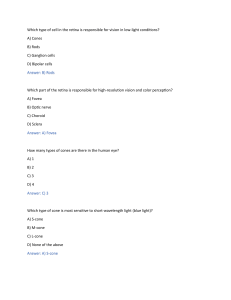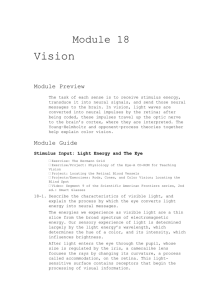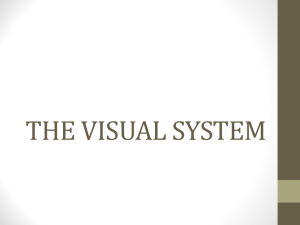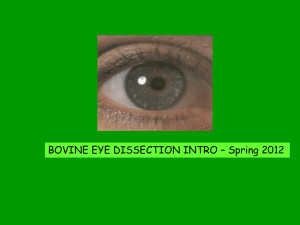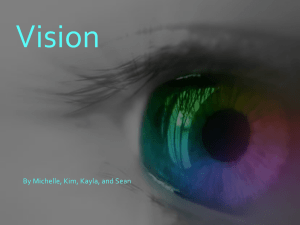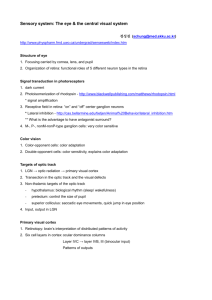4.2 Reading Guide
advertisement
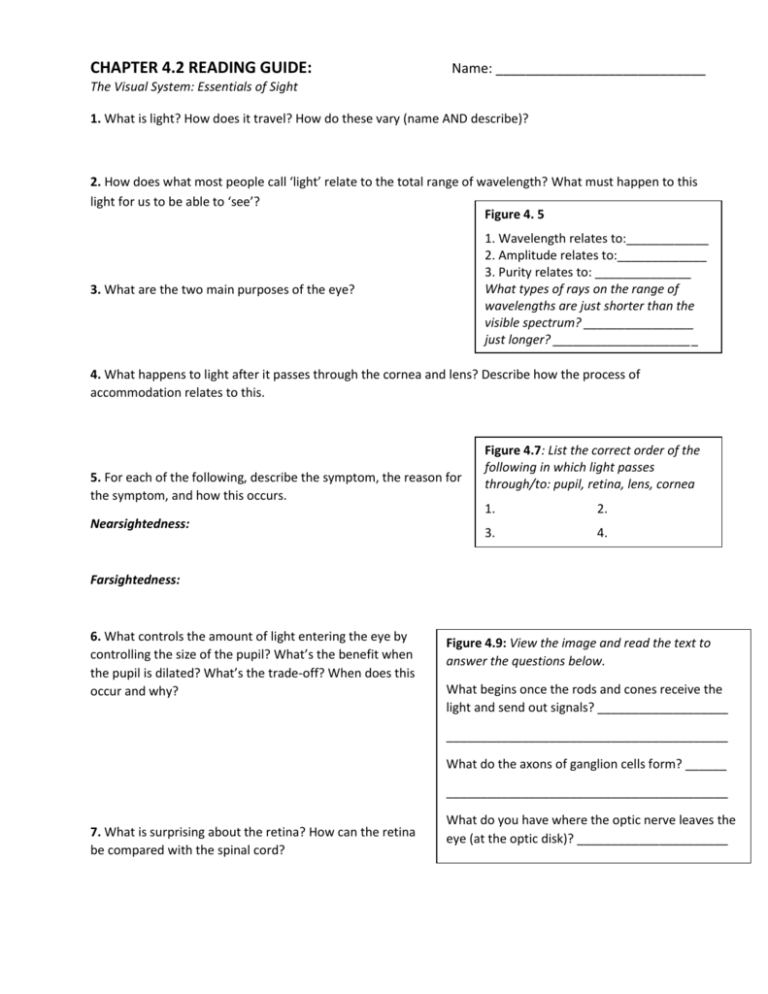
CHAPTER 4.2 READING GUIDE: Name: ____________________________ The Visual System: Essentials of Sight 1. What is light? How does it travel? How do these vary (name AND describe)? 2. How does what most people call ‘light’ relate to the total range of wavelength? What must happen to this light for us to be able to ‘see’? Figure 4. 5 1. Wavelength relates to:____________ 2. Amplitude relates to:_____________ 3. Purity relates to: ______________ What types of rays on the range of wavelengths are just shorter than the visible spectrum? ________________ just longer? _____________________ 3. What are the two main purposes of the eye? 4. What happens to light after it passes through the cornea and lens? Describe how the process of accommodation relates to this. 5. For each of the following, describe the symptom, the reason for the symptom, and how this occurs. Nearsightedness: Figure 4.7: List the correct order of the following in which light passes through/to: pupil, retina, lens, cornea 1. 2. 3. 4. Farsightedness: 6. What controls the amount of light entering the eye by controlling the size of the pupil? What’s the benefit when the pupil is dilated? What’s the trade-off? When does this occur and why? Figure 4.9: View the image and read the text to answer the questions below. What begins once the rods and cones receive the light and send out signals? ___________________ _________________________________________ What do the axons of ganglion cells form? ______ _________________________________________ 7. What is surprising about the retina? How can the retina be compared with the spinal cord? What do you have where the optic nerve leaves the eye (at the optic disk)? ______________________ 8. For each of the following types of receptor cells in the retina, discuss A) the type of vision each specializes in, B) how they respond to bright vs. dim light, C) their sensitivity to detail, and D) their location in relation to the fovea. Cones: Rods: 9. What do both dark and light adaptation have in common in terms of visual acuity? 10. What do light striking rods and cones trigger? What does this do in turn? What does this carry? To where? Figure 4.12 Where does input from the left half of the visual field go? _______________________ Which hemisphere is it sent to? _________ 11. Why do the optic nerves from the inside half of each eye cross over at the optic chiasm? What do the majority of nerve fibers pass through after the optic chiasm (one word)? ______________________ From there they go to the ____________________________ 12. What are cells in the primary visual cortex actually sensitive to? Who found this out? What is the key point of all this? Figure 4.13 What does viewing a vertical line do to the firing of a specific neuron cell in the CAT’s visual cortex? ________________ A horizontal line? __________________ 13. What happens to visual input after it’s processed in the visual cortex? As the input moves further along the system, what can you say about neurons? 14. What is and what isn’t the probable explanation for cases of visual agnosia? 15. What do the findings of the study related to Greebies say about the functional organization of the brain? 16. How do the lights with the longest and shortest wavelengths appear in the visible spectrum? Why should we take note of the word ‘appear’? If that is true, then what does our perception of color depend on? 17. How much light is left in relation to what was originally there for subtractive mixing? Additive mixing? Figure 4.17 18. How does the trichromatic theory of color vision explain people’s ability to see all the colors of the rainbow? Explain a practical application of this theory. What color do you get when you add red, green and blue lights all together? ___________ What do you get when you do the same for paint? _____________ 19. Explain how the trichromatic theory also meshes with what is currently known about color blindness. Elaborate on your first response by using the Reality Check box to explain why the misconception that colorblind people see the world in black and white is wrong. 20. What is one argument against the trichromatic theory? How does the color yellow fit in to another argument against it? Figure 4.18: If you stare at the color red and then look at a blank piece of white paper, what color will you see? ________________ If you look at green? ________________ What do you get if you mix either of the above pairs? __________ 21. What is main point of opponent process theory of color vision, including two reason that lend validity to the theory? Figure 4.19: Which theory of color processing does the figure verify? _________________________________ What is another way to describe the wavelengths blue, green, and red cones are receptive to? __________________ ________________________________ 22. Summarize how the two theories of color vision have been reconciled. 23. Give two reasons why the color red is associated has a negative effect on performance in achievement settings.

